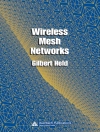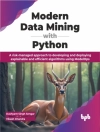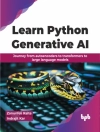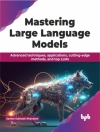When considering the idea of using machine learning in healthcare, it is a Herculean task to present the entire gamut of information in the field of intelligent systems. It is, therefore the objective of this book to keep the presentation narrow and intensive. This approach is distinct from others in that it presents detailed computer simulations for all models presented with explanations of the program code. It includes unique and distinctive chapters on disease diagnosis, telemedicine, medical imaging, smart health monitoring, social media healthcare, and machine learning for COVID-19. These chapters help develop a clear understanding of the working of an algorithm while strengthening logical thinking. In this environment, answering a single question may require accessing several data sources and calling on sophisticated analysis tools. While data integration is a dynamic research area in the database community, the specific needs of research have led to the development of numerous middleware systems that provide seamless data access in a result-driven environment.
Since this book is intended to be useful to a wide audience, students, researchers and scientists from both academia and industry may all benefit from this material. It contains a comprehensive description of issues for healthcare data management and an overview of existing systems, making it appropriate for introductory and instructional purposes. Prerequisites are minimal; the readers are expected to have basic knowledge of machine learning.
This book is divided into 22 real-time innovative chapters which provide a variety of application examples in different domains. These chapters illustrate why traditional approaches often fail to meet customers’ needs. The presented approaches provide a comprehensive overview of current technology. Each of these chapters, which are written by the main inventors of the presented systems, specifies requirements and provides a description of both the chosen approach and its implementation. Because of the self-contained nature of these chapters, they may be read in any order. Each of the chapters use various technical terms which involve expertise in machine learning and computer science.
Cuprins
Preface xvii
Part 1: Introduction to Intelligent Healthcare Systems 1
1 Innovation on Machine Learning in Healthcare Services—An Introduction 3
Parthasarathi Pattnayak and Om Prakash Jena
1.1 Introduction 3
1.2 Need for Change in Healthcare 5
1.3 Opportunities of Machine Learning in Healthcare 6
1.4 Healthcare Fraud 7
1.4.1 Sorts of Fraud in Healthcare 7
1.4.2 Clinical Service Providers 8
1.4.3 Clinical Resource Providers 8
1.4.4 Protection Policy Holders 8
1.4.5 Protection Policy Providers 9
1.5 Fraud Detection and Data Mining in Healthcare 9
1.5.1 Data Mining Supervised Methods 10
1.5.2 Data Mining Unsupervised Methods 10
1.6 Common Machine Learning Applications in Healthcare 10
1.6.1 Multimodal Machine Learning for Data Fusion in Medical Imaging 11
1.6.2 Machine Learning in Patient Risk Stratification 11
1.6.3 Machine Learning in Telemedicine 11
1.6.4 AI (ML) Application in Sedate Revelation 12
1.6.5 Neuroscience and Image Computing 12
1.6.6 Cloud Figuring Systems in Building AI-Based Healthcare 12
1.6.7 Applying Internet of Things and Machine-Learning for Personalized Healthcare 12
1.6.8 Machine Learning in Outbreak Prediction 13
1.7 Conclusion 13
References 14
Part 2: Machine Learning/Deep Learning-Based Model Development 17
2 A Framework for Health Status Estimation Based on Daily Life Activities Data Using Machine Learning Techniques 19
Tene Ramakrishnudu, T. Sai Prasen and V. Tharun Chakravarthy
2.1 Introduction 19
2.1.1 Health Status of an Individual 19
2.1.2 Activities and Measures of an Individual 20
2.1.3 Traditional Approach to Predict Health Status 20
2.2 Background 20
2.3 Problem Statement 21
2.4 Proposed Architecture 22
2.4.1 Pre-Processing 22
2.4.2 Phase-I 23
2.4.3 Phase-II 23
2.4.4 Dataset Generation 23
2.4.4.1 Rules Collection 23
2.4.4.2 Feature Selection 24
2.4.4.3 Feature Reduction 24
2.4.4.4 Dataset Generation From Rules 24
2.4.4.5 Example 24
2.4.5 Pre-Processing 26
2.5 Experimental Results 27
2.5.1 Performance Metrics 27
2.5.1.1 Accuracy 27
2.5.1.2 Precision 28
2.5.1.3 Recall 28
2.5.1.4 F1-Score 30
2.6 Conclusion 31
References 31
3 Study of Neuromarketing With EEG Signals and Machine Learning Techniques 33
S. Pal, P. Das, R. Sahu and S.R. Dash
3.1 Introduction 34
3.1.1 Why BCI 34
3.1.2 Human–Computer Interfaces 34
3.1.3 What is EEG 35
3.1.4 History of EEG 35
3.1.5 About Neuromarketing 35
3.1.6 About Machine Learning 36
3.2 Literature Survey 36
3.3 Methodology 45
3.3.1 Bagging Decision Tree Classifier 45
3.3.2 Gaussian Naïve Bayes Classifier 45
3.3.3 Kernel Support Vector Machine (Sigmoid) 45
3.3.4 Random Decision Forest Classifier 46
3.4 System Setup & Design 46
3.4.1 Pre-Processing & Feature Extraction 47
3.4.1.1 Savitzky–Golay Filter 47
3.4.1.2 Discrete Wavelet Transform 48
3.4.2 Dataset Description 49
3.5 Result 49
3.5.1 Individual Result Analysis 49
3.5.2 Comparative Results Analysis 52
3.6 Conclusion 53
References 54
4 An Expert System-Based Clinical Decision Support System for Hepatitis-B Prediction & Diagnosis 57
Niranjan Panigrahi, Ishan Ayus and Om Prakash Jena
4.1 Introduction 57
4.2 Outline of Clinical DSS 59
4.2.1 Preliminaries 59
4.2.2 Types of Clinical DSS 60
4.2.3 Non-Knowledge-Based Decision Support System (NK-DSS) 60
4.2.4 Knowledge-Based Decision Support System (K-DSS) 62
4.2.5 Hybrid Decision Support System (H-DSS) 64
4.2.6 DSS Architecture 64
4.3 Background 65
4.4 Proposed Expert System-Based CDSS 65
4.4.1 Problem Description 65
4.4.2 Rules Set & Knowledge Base 66
4.4.3 Inference Engine 66
4.5 Implementation & Testing 66
4.6 Conclusion 73
References 73
5 Deep Learning on Symptoms in Disease Prediction 77
Sheikh Raul Islam, Rohit Sinha, Santi P. Maity and Ajoy Kumar Ray
5.1 Introduction 77
5.2 Literature Review 78
5.3 Mathematical Models 79
5.3.1 Graphs and Related Terms 80
5.3.2 Deep Learning in Graph 80
5.3.3 Network Embedding 80
5.3.4 Graph Neural Network 81
5.3.5 Graph Convolution Network 82
5.4 Learning Representation From DSN 82
5.4.1 Description of the Proposed Model 83
5.4.2 Objective Function 84
5.5 Results and Discussion 84
5.5.1 Description of the Dataset 85
5.5.2 Training Progress 85
5.5.3 Performance Comparisons 86
5.6 Conclusions and Future Scope 86
References 87
6 Intelligent Vision-Based Systems for Public Safety and Protection via Machine Learning Techniques 89
Rajitha B.
6.1 Introduction 89
6.1.1 Problems Intended in Video Surveillance Systems 90
6.1.2 Current Developments in This Area 91
6.1.3 Role of AI in Video Surveillance Systems 91
6.2 Public Safety and Video Surveillance Systems 92
6.2.1 Offline Crime Prevention 92
6.2.2 Crime Prevention and Identification via Apps 92
6.2.3 Crime Prevention and Identification via CCTV 92
6.3 Machine Learning for Public Safety 94
6.3.1 Abnormality Behavior Detection via Deep Learning 95
6.3.2 Video Analytics Methods for Accident Classification/Detection 97
6.3.3 Feature Selection and Fusion Methods 98
6.4 Securing the CCTV Data 99
6.4.1 Image/Video Security Challenges 99
6.4.2 Blockchain for Image/Video Security 99
6.5 Conclusion 99
References 100
7 Semantic Framework in Healthcare 103
Sankar Pariserum Perumal, Ganapathy Sannasi, Selvi M. and Kannan Arputharaj
7.1 Introduction 103
7.2 Semantic Web Ontology 104
7.3 Multi-Agent System in a Semantic Framework 106
7.3.1 Existing Healthcare Semantic Frameworks 107
7.3.1.1 AOIS 107
7.3.1.2 SCKE 108
7.3.1.3 MASE 109
7.3.1.4 MET4 110
7.3.2 Proposed Multi-Agent-Based Semantic Framework for Healthcare Instance Data 111
7.3.2.1 Data Dictionary 111
7.3.2.2 Mapping Database 112
7.3.2.3 Decision Making Ontology 113
7.3.2.4 STTL and SPARQL-Based RDF Transformation 115
7.3.2.5 Query Optimizer Agent 116
7.3.2.6 Semantic Web Services Ontology 116
7.3.2.7 Web Application User Interface and Customer Agent 116
7.3.2.8 Translation Agent 117
7.3.2.9 RDF Translator 117
7.4 Conclusion 118
References 119
8 Detection, Prediction & Intervention of Attention Deficiency in the Brain Using t DCS 121
Pallabjyoti Kakoti, Rissnalin Syiemlieh and Eeshankur Saikia
8.1 Introduction 121
8.2 Materials & Methods 123
8.2.1 Subjects and Experimental Design 123
8.2.2 Data Pre-Processing & Statistical Analysis 125
8.2.3 Extracting Singularity Spectrum from EEG 126
8.3 Results & Discussion 126
8.4 Conclusion 132
Acknowledgement 133
References 133
9 Detection of Onset and Progression of Osteoporosis Using Machine Learning 137
Shilpi Ruchi Kerketta and Debalina Ghosh
9.1 Introduction 137
9.1.1 Measurement Techniques of BMD 138
9.1.2 Machine Learning Algorithms in Healthcare 138
9.1.3 Organization of Chapter 139
9.2 Microwave Characterization of Human Osseous Tissue 139
9.2.1 Frequency-Domain Analysis of Human Wrist Sample 140
9.2.2 Data Collection and Analysis 141
9.3 Prediction Model of Osteoporosis Using Machine Learning Algorithms 144
9.3.1 K-Nearest Neighbor (KNN) 144
9.3.2 Decision Tree 145
9.3.3 Random Forest 145
9.4 Conclusion 148
Acknowledgment 148
References 148
10 Applications of Machine Learning in Biomedical Text Processing and Food Industry 151
K. Paramesha, Gururaj H.L. and Om Prakash Jena
10.1 Introduction 152
10.2 Use Cases of AI and ML in Healthcare 153
10.2.1 Speech Recognition (SR) 153
10.2.2 Pharmacovigilance and Adverse Drug Effects (ADE) 153
10.2.3 Clinical Imaging and Diagnostics 153
10.2.4 Conversational AI in Healthcare 154
10.3 Use Cases of AI and ML in Food Technology 154
10.3.1 Assortment of Vegetables and Fruits 154
10.3.2 Personal Hygiene 154
10.3.3 Developing New Products 155
10.3.4 Plant Leaf Disease Detection 156
10.3.5 Face Recognition Systems for Domestic Cattle 156
10.3.6 Cleaning Processing Equipment 157
10.4 A Case Study: Sentiment Analysis of Drug Reviews 158
10.4.1 Dataset 159
10.4.2 Approaches for Sentiment Analysis on Drug Reviews 159
10.4.3 Bo W and TF-IDF Model 160
10.4.4 Bi-LSTM Model 160
10.4.4.1 Word Embedding 160
10.4.5 Deep Learning Model 161
10.5 Results and Analysis 164
10.6 Conclusion 165
References 166
11 Comparison of Mobile Net and Res Net CNN Architectures in the CNN-Based Skin Cancer Classifier Model 169
Subasish Mohapatra, N.V.S. Abhishek, Dibyajit Bardhan, Anisha Ankita Ghosh and Shubhadarshinin Mohanty
11.1 Introduction 169
11.2 Our Skin Cancer Classifier Model 171
11.3 Skin Cancer Classifier Model Results 172
11.4 Hyperparameter Tuning and Performance 174
11.4.1 Hyperparameter Tuning of Mobile Net-Based CNN Model 175
11.4.2 Hyperparameter Tuning of Res Net50-Based CNN Model 175
11.4.3 Table Summary of Hyperparameter Tuning Results 176
11.5 Comparative Analysis and Results 176
11.5.1 Training and Validation Loss 177
11.5.1.1 Mobile Net 177
11.5.1.2 Res Net50 177
11.5.1.3 Inferences 177
11.5.2 Training and Validation Categorical Accuracy 178
11.5.2.1 Mobile Net 178
11.5.2.2 Res Net50 178
11.5.2.3 Inferences 178
11.5.3 Training and Validation Top 2 Accuracy 179
11.5.3.1 Mobile Net 179
11.5.3.2 Res Net50 179
11.5.3.3 Inferences 180
11.5.4 Training and Validation Top 3 Accuracy 180
11.5.4.1 Mobile Net 180
11.5.4.2 Res Net50 180
11.5.4.3 Inferences 181
11.5.5 Confusion Matrix 181
11.5.5.1 Mobile Net 181
11.5.5.2 Res Net50 181
11.5.5.3 Inferences 182
11.5.6 Classification Report 182
11.5.6.1 Mobile Net 182
11.5.6.2 Res Net50 182
11.5.6.3 Inferences 183
11.5.7 Last Epoch Results 183
11.5.7.1 Mobile Net 183
11.5.7.2 Res Net50 183
11.5.7.3 Inferences 184
11.5.8 Best Epoch Results 184
11.5.8.1 Mobile Net 184
11.5.8.2 Res Net50 184
11.5.8.3 Inferences 184
11.5.9 Overall Comparative Analysis 184
11.6 Conclusion 185
References 185
12 Deep Learning-Based Image Classifier for Malaria Cell Detection 187
Alok Negi, Krishan Kumar and Prachi Chauhan
12.1 Introduction 187
12.2 Related Work 189
12.3 Proposed Work 190
12.3.1 Dataset Description 191
12.3.2 Data Pre-Processing and Augmentation 191
12.3.3 CNN Architecture and Implementation 192
12.4 Results and Evaluation 194
12.5 Conclusion 196
References 197
13 Prediction of Chest Diseases Using Transfer Learning 199
S. Baghavathi Priya, M. Rajamanogaran and S. Subha
13.1 Introduction 199
13.2 Types of Diseases 200
13.2.1 Pneumothorax 200
13.2.2 Pneumonia 200
13.2.3 Effusion 200
13.2.4 Atelectasis 201
13.2.5 Nodule and Mass 202
13.2.6 Cardiomegaly 202
13.2.7 Edema 202
13.2.8 Lung Consolidation 202
13.2.9 Pleural Thickening 202
13.2.10 Infiltration 202
13.2.11 Fibrosis 203
13.2.12 Emphysema 203
13.3 Diagnosis of Lung Diseases 204
13.4 Materials and Methods 204
13.4.1 Data Augmentation 206
13.4.2 CNN Architecture 206
13.4.3 Lung Disease Prediction Model 207
13.5 Results and Discussions 208
13.5.1 Implementation Results Using ROC Curve 209
13.6 Conclusion 210
References 212
14 Early Stage Detection of Leukemia Using Artificial Intelligence 215
Neha Agarwal and Piyush Agrawal
14.1 Introduction 215
14.1.1 Classification of Leukemia 216
14.1.1.1 Acute Lymphocytic Leukemia 216
14.1.1.2 Acute Myeloid Leukemia 216
14.1.1.3 Chronic Lymphocytic Leukemia 216
14.1.1.4 Chronic Myeloid Leukemia 216
14.1.2 Diagnosis of Leukemia 216
14.1.3 Acute and Chronic Stages of Leukemia 217
14.1.4 The Role of AI in Leukemia Detection 217
14.2 Literature Review 219
14.3 Proposed Work 220
14.3.1 Modules Involved in Proposed Methodology 221
14.3.2 Flowchart 222
14.3.3 Proposed Algorithm 223
14.4 Conclusion and Future Aspects 223
References 223
Part 3: Internet of Medical Things (Io MT) for Healthcare 225
15 Io T Application in Interconnected Hospitals 227
Subhra Debdas, Chinmoy Kumar Panigrahi, Priyasmita Kundu, Sayantan Kundu and Ramanand Jha
15.1 Introduction 228
15.2 Networking Systems Using Io T 229
15.3 What are Smart Hospitals? 233
15.3.1 Environment of a Smart Hospital 234
15.4 Assets 236
15.4.1 Overview of Smart Hospital Assets 236
15.4.2 Exigency of Automated Healthcare Center Assets 239
15.5 Threats 241
15.5.1 Emerging Vulnerabilities 241
15.5.2 Threat Analysis 244
15.6 Conclusion 246
References 246
16 Real Time Health Monitoring Using Io T With Integration of Machine Learning Approach 249
K.G. Maheswari, G. Nalinipriya, C. Siva and A. Thilakesh Raj
16.1 Introduction 250
16.2 Related Work 250
16.3 Existing Healthcare Monitoring System 251
16.4 Methodology and Data Analysis 251
16.5 Proposed System Architecture 252
16.6 Machine Learning Approach 252
16.6.1 Multiple Linear Regression Algorithm 253
16.6.2 Random Forest Algorithm 253
16.6.3 Support Vector Machine 253
16.7 Work Flow of the Proposed System 253
16.8 System Design of Health Monitoring System 256
16.9 Use Case Diagram 257
16.10 Conclusion 258
References 259
Part 4: Machine Learning Applications for COVID-19 261
17 Semantic and NLP-Based Retrieval From Covid-19 Ontology 263
Ramar Kaladevi and Appavoo Revathi
17.1 Introduction 263
17.2 Related Work 264
17.3 Proposed Retrieval System 266
17.3.1 Why Ontology? 266
17.3.2 Covid Ontology 266
17.3.3 Information Retrieval From Ontology 269
17.3.4 Query Formulation 272
17.3.5 Retrieval From Knowledgebase 272
17.4 Conclusion 273
References 273
18 Semantic Behavior Analysis of COVID-19 Patients: A Collaborative Framework 277
Amlan Mohanty, Debasish Kumar Mallick, Shantipriya Parida and Satya Ranjan Dash
18.1 Introduction 278
18.2 Related Work 280
18.2.1 Semantic Analysis and Topic Discovery of Alcoholic Patients From Social Media Platforms 280
18.2.2 Sentiment Analysis of Tweets From Twitter Handles of the People of Nepal in Response to the COVID-19 Pandemic 280
18.2.3 Study of Sentiment Analysis and Analyzing Scientific Papers 280
18.2.4 Informatics and COVID-19 Research 281
18.2.5 COVID-19 Outbreak in the World and Twitter Sentiment Analysis 281
18.2.6 LDA Topic Modeling on Twitter to Study Public Discourse and Sentiment During the Coronavirus Pandemic 281
18.2.7 The First Decade of Research on Sentiment Analysis 282
18.2.8 Detailed Survey on the Semantic Analysis Techniques for NLP 282
18.2.9 Understanding Text Semantics With LSA 282
18.2.10 Analyzing Suicidal Tendencies With Semantic Analysis Using Social Media 283
18.2.11 Analyzing Public Opinion on BREXIT Using Sentiment Analysis 283
18.2.12 Prediction of Indian Elections Using NLP and Decision Tree 283
18.3 Methodology 283
18.4 Conclusion 286
References 287
19 Comparative Study of Various Data Mining Techniques Towards Analysis and Prediction of Global COVID-19 Dataset 289
Sachin Kamley
19.1 Introduction 289
19.2 Literature Review 290
19.3 Materials and Methods 292
19.3.1 Dataset Collection 292
19.3.2 Support Vector Machine (SVM) 292
19.3.3 Decision Tree (DT) 294
19.3.4 K-Means Clustering 294
19.3.5 Back Propagation Neural Network (BPNN) 295
19.4 Experimental Results 296
19.5 Conclusion and Future Scopes 305
References 306
20 Automated Diagnosis of COVID-19 Using Reinforced Lung Segmentation and Classification Model 309
J. Shiny Duela and T. Illakiya
20.1 Introduction 309
20.2 Diagnosis of COVID-19 310
20.2.1 Pre-Processing of Lung CT Image 310
20.2.2 Lung CT Image Segmentation 311
20.2.3 ROI Extraction 311
20.2.4 Feature Extraction 311
20.2.5 Classification 311
20.3 Genetic Algorithm (GA) 311
20.3.1 Operators of GA 312
20.3.2 Applications of GA 312
20.4 Related Works 313
20.5 Challenges in GA 314
20.6 Challenges in Lung CT Segmentation 314
20.7 Proposed Diagnosis Framework 314
20.7.1 Image Pre-Processing 315
20.7.2 Proposed Image Segmentation Technique 315
20.7.3 ROI Segmentation 318
20.7.4 Feature Extraction 318
20.7.5 Modified GA Classifier 318
20.7.5.1 Gaussian Type—II Fuzzy in Classification 318
20.7.5.2 Classifier Algorithm 319
20.8 Result Discussion 319
20.9 Conclusion 321
References 321
Part 5: Case Studies of Application Areas of Machine Learning in Healthcare System 323
21 Future of Telemedicine with ML: Building a Telemedicine Framework for Lung Sound Detection 325
Sudhansu Shekhar Patra, Nitin S. Goje, Kamakhya Narain Singh, Kaish Q. Khan, Deepak Kumar, Madhavi and Kumar Ashutosh Sharma
21.1 Introduction 325
21.1.1 Monitoring the Remote Patient 326
21.1.2 Intelligent Assistance for Patient Diagnosis 326
21.1.3 Fasten Electronic Health Record Retrieval Process 326
21.1.4 Collaboration Increases Among Healthcare Practitioners 326
21.2 Related Work 327
21.3 Strategic Model for Telemedicine 328
21.4 Framework for Lung Sound Detection in Telemedicine 330
21.4.1 Data Collection 330
21.4.2 Pre-Processing of Data 331
21.4.3 Feature Extraction 331
21.4.3.1 MFCC 331
21.4.3.2 Lung Sounds Using Multi Resolution DWT 332
21.4.4 Classification 334
21.4.4.1 Correlation Coefficient for Feature Selection (CFS) 334
21.4.4.2 Symmetrical Uncertainty 334
21.4.4.3 Gain Ratio 335
21.4.4.4 Modified RF Classification Architecture 335
21.5 Experimental Analysis 335
21.6 Conclusion 340
References 340
22 A Lightweight Convolutional Neural Network Model for Tuberculosis Bacilli Detection From Microscopic Sputum Smear Images 343
Rani Oomman Panicker, S.J. Pawan, Jeny Rajan and M.K. Sabu
22.1 Introduction 343
22.2 Literature Review 345
22.3 Proposed Work 346
22.4 Experimental Results and Discussion 349
22.5 Conclusion 350
References 350
23 Role of Machine Learning and Texture Features for the Diagnosis of Laryngeal Cancer 353
Vibhav Prakash Singh and Ashish Kumar Maurya
23.1 Introduction 353
23.2 Clinically Correlated Texture Features 358
23.2.1 Texture-Based LBP Descriptors 358
23.2.2 GLCM Features 358
23.2.3 Statistical Features 359
23.3 Machine Learning Techniques 359
23.3.1 Support Vector Machine (SVM) 359
23.3.2 k-NN (k-Nearest Neighbors) 360
23.3.3 Random Forest (RF) 361
23.3.4 Naïve Bayes 361
23.4 Result Analysis and Discussions 361
23.5 Conclusions 366
References 366
24 Analysis of Machine Learning Technologies for the Detection of Diabetic Retinopathy 369
Biswabijayee Chandra Sekhar Mohanty, Sonali Mishra and Sambit Kumar Mishra
24.1 Introduction 369
24.2 Related Work 370
24.2.1 Pre-Processing of Image 371
24.2.2 Diabetic Retinopathy Detection 372
24.2.3 Grading of DR 374
24.3 Dataset Used 374
24.3.1 DIARETDB1 374
24.3.2 Diabetic-Retinopathy-Detection Dataset 376
24.4 Methodology Used 377
24.4.1 Pre-Processing 377
24.4.2 Segmentation 377
24.4.3 Feature Extraction 378
24.4.4 Classification 378
24.5 Analysis of Results and Discussion 379
24.6 Conclusion 380
References 381
Index 383
Despre autor
Sachi Nandan Mohanty received his Ph D from IIT Kharagpur in 2015. He has recently joined as an associate professor in the Department of Computer Science & Engineering at ICFAI Foundation for Higher Education Hyderabad. His research areas include data mining, big data analysis, cognitive science, fuzzy decision making, brain-computer interface, and computational intelligence. He has published 20 SCI journal articles and has authored/edited 7 books.
G. Nalinipriya is a professor in the Department of Information Technology, Anna University, Chennai where she also obtained her Ph D. She has more than 23 years of experience in the field of teaching, industry and research and her interests include artificial intelligence, machine learning, data science and cloud security.
Om Prakash Jena is an assistant professor in the Department of Computer Science, Ravenshaw University, Cuttack, Odisha. He has 10 years of teaching and research experience and has published several technical papers in international journals/conferences/edited books. His current research interests include pattern recognition, cryptography, network security, soft computing, data analytics and machine automation.
Achyuth Sarkar received his Ph D in Computer Science and Engineering from the National Institute of Technology, Arunachal Pradesh in 2019. He has teaching experience of more than 10 years.












